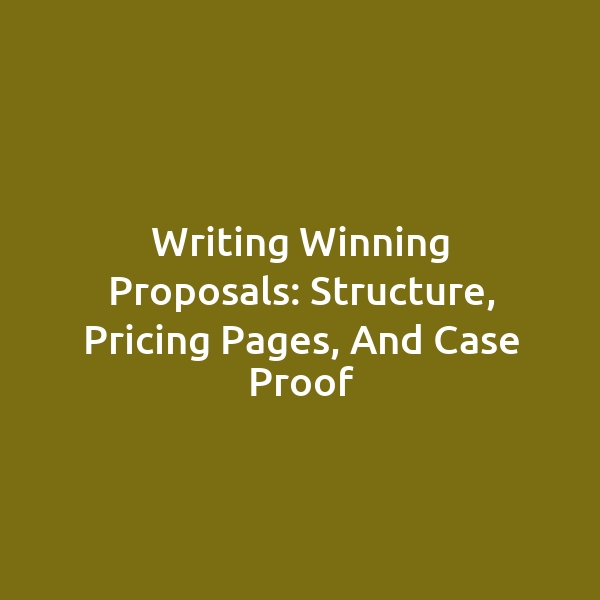Winning proposals are crucial for securing new business and fostering relationships. Understanding the structure, pricing pages, and case proof can make your proposal stand out. A well-organized proposal reflects professionalism and competence. It showcases your understanding of the client’s needs. Crafting a compelling proposal involves several essential components. This article will guide you through the process of writing winning proposals. We will discuss structure, pricing pages, and case proof in detail. Let’s dive into how to create proposals that win contracts and impress clients.
Understanding the Structure of a Winning Proposal

A well-structured proposal is easy to navigate and understand. It starts with a clear introduction and an executive summary. The introduction should outline the proposal’s purpose. It sets the stage for the entire document. The executive summary highlights key points succinctly.
After the summary, include a detailed project description. This section explains the problem and your proposed solution. Make it specific and tailored to the client’s needs. Clearly state your objectives and how you plan to achieve them.
Next, outline the scope of work. Define what is included and excluded. This helps manage client expectations. Clarity in this section can prevent misunderstandings later.
Include a timeline for the project. Break it down into phases if necessary. This shows your organizational skills and ability to meet deadlines.
Finally, list the necessary resources and personnel. Highlight key team members and their qualifications. This reassures the client of your capability to deliver.
In summary, a structured proposal is logical and organized. It guides the reader through your plan seamlessly. A clear structure enhances the proposal’s professionalism.
Crafting Effective Pricing Pages

Pricing pages are a critical component of any proposal. They must be transparent and justifiable. Begin with a clear breakdown of costs. Use tables or charts for easy comprehension.
Include both direct and indirect costs. Direct costs relate to specific project components. Indirect costs cover overheads and administrative expenses.
Offer different pricing options if possible. This gives the client flexibility. It can also accommodate varying budget constraints. Clearly state what each option includes.
Explain the pricing rationale. Justify your costs with data or benchmarks. This builds trust with the client. They will appreciate the transparency.
Include terms of payment in this section. Specify when payments are due. Mention any penalties for late payments. This prevents future disputes.
To conclude, effective pricing pages are clear and detailed. They demonstrate value and justify costs. A well-crafted pricing page can be persuasive.
Using Case Proof to Strengthen Proposals

Case proof adds credibility to your proposal. It demonstrates past success and experience. Start by including case studies of similar projects.
Choose case studies that align with the client’s industry. Highlight the challenges faced and how they were overcome. Include measurable outcomes and benefits.
Use testimonials from previous clients. Quotes from satisfied clients can be persuasive. They provide an external validation of your capabilities.
Incorporate relevant statistics and data. These can support your claims and add weight. Use graphs or charts for visual impact.
Anecdotal evidence can also be effective. Share stories of how your team solved problems. This personal touch can resonate with clients.
In summary, case proof builds trust and confidence. It showcases your track record and expertise. Strong case proof can tip the scales in your favor.
Tips for Writing a Compelling Proposal

Writing a compelling proposal requires attention to detail. Start by thoroughly understanding the client’s needs. Tailor your proposal to address these specific needs.
Use clear and concise language. Avoid jargon and complex terms. This ensures your message is understood.
Maintain a professional tone throughout. Be respectful and courteous. This reflects positively on your company.
Proofread your proposal carefully. Typos and errors can undermine your credibility. A polished document is essential.
Include a strong call to action. Encourage the client to take the next step. Make it easy for them to contact you.
In conclusion, a compelling proposal is clear, tailored, and professional. It communicates effectively and leaves a lasting impression.
Common Mistakes to Avoid in Proposals

Several common mistakes can hinder proposal success. One is failing to customize the proposal. Generic proposals lack impact.
Avoid overloading with information. Be concise and to the point. Too much detail can overwhelm the client.
Neglecting the client’s perspective is another mistake. Focus on their needs and benefits. The proposal should be client-centered.
Ignoring the importance of design is also detrimental. A visually appealing proposal stands out. Use headings, bullet points, and spacing effectively.
Finally, not following up can be a missed opportunity. A follow-up shows interest and professionalism. It can make a difference in winning the contract.
In summary, avoiding these mistakes enhances proposal success. A well-crafted proposal is customized, concise, and client-focused.
Conclusion: Key Takeaways for Winning Proposals

Winning proposals require a strategic approach. The structure is crucial for clarity and organization. Pricing pages must be transparent and justified. Case proof adds credibility and trust.
Tailor your proposal to the client’s needs. Use clear language and maintain professionalism. Avoid common mistakes and follow up diligently.
A well-crafted proposal can secure business and build relationships. It showcases your expertise and understanding. With these elements, your proposals will stand out and win contracts.
